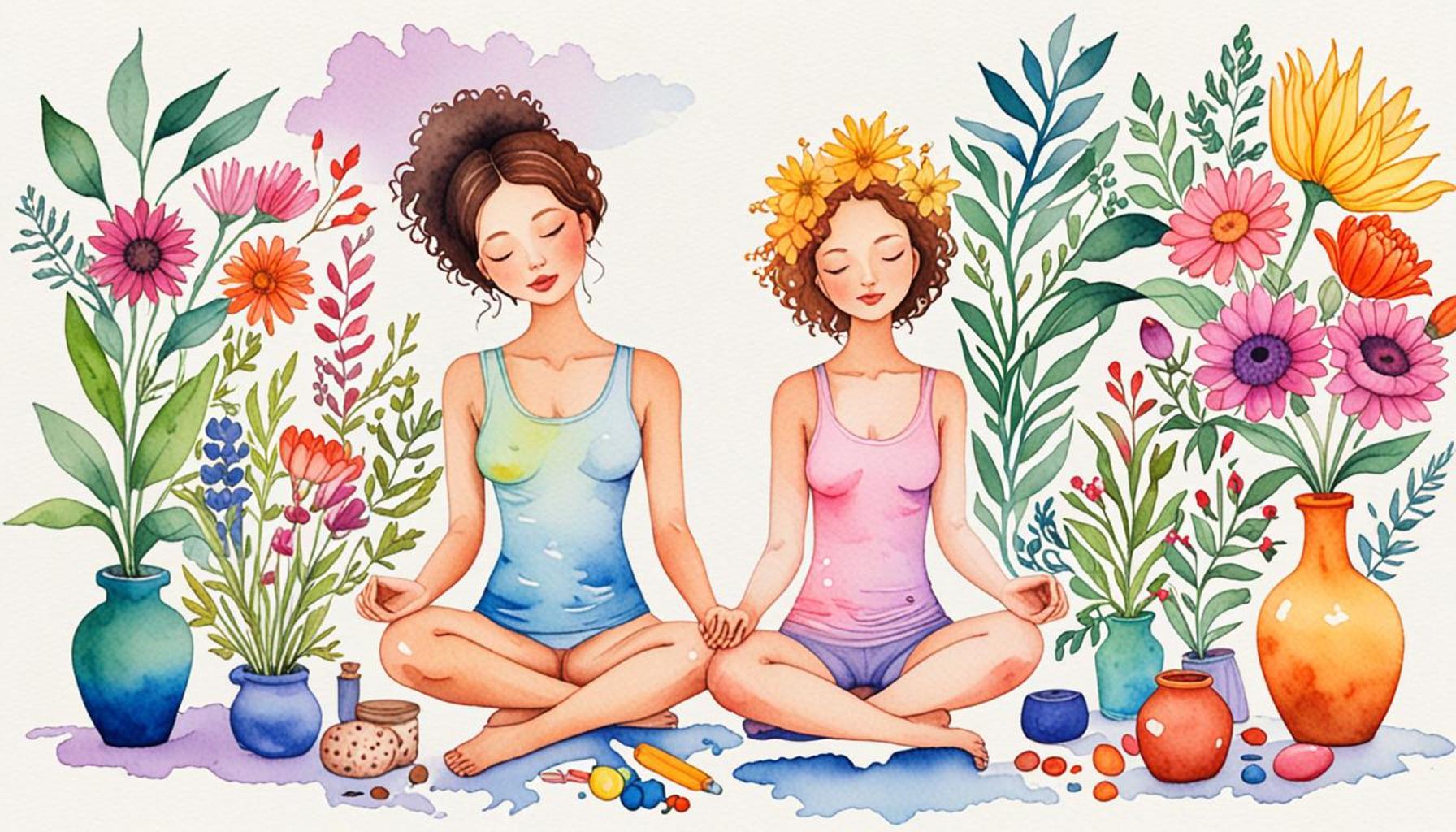Discover Mindful Living A Modern Approach to Inner Peace

Understanding the Essence of Mindfulness
As we navigate through the relentless pace of modern life, the quest for inner peace becomes increasingly paramount. The pressures of work, family obligations, and societal demands can contribute to a feeling of overwhelm. In response to this, many are discovering the transformative potential of mindful living—a practical and accessible approach that is gaining momentum across the United States.
What is Mindful Living?
At its core, mindful living involves cultivating a heightened state of awareness towards the present moment. This practice does not require one to be spiritual or even particularly introspective; rather, it offers straightforward techniques that can lead to lasting benefits. By focusing on the present, individuals can:
- Reduce stress by anchoring themselves in the here and now, allowing worries about the past or future to dissipate.
- Enhance emotional well-being through thoughtful self-reflection, fostering acceptance of one’s thoughts and feelings rather than reacting impulsively.
- Improve physical health by facilitating relaxation, which can lower blood pressure, reduce muscle tension, and improve overall vitality.
Practices to Incorporate Mindfulness
Various techniques rooted in mindfulness are becoming popular among Americans seeking to cultivate a deeper connection with themselves and their environment. Practices such as meditation, yoga, and specific breathing exercises serve as effective gateways to achieving mindful living. For instance, a simple 10-minute breathing exercise, where one focuses solely on inhaling and exhaling, can significantly calm the mind and reduce anxiety.
Yoga, specifically styles like Hatha or Vinyasa Flow, can also integrate mindfulness into physical movement. Participants learn to synchronize their breath with their movements, creating a flow that fosters concentration and physical awareness. Studies have shown that regular yoga practice can enhance mental clarity and resiliency in dealing with stress.
Making Mindfulness Part of Your Daily Routine
The concept of mindful living can be seamlessly integrated into daily activities. Techniques such as mindful eating—where one savors each bite and pays attention to sensations—can transform meal times into moments of tranquility. Similarly, mindful walking encourages an awareness of one’s surroundings, blending movement with an appreciation for nature, even on a bustling city street.
As we explore the intricacies of mindful living, it’s essential to understand that small, consistent changes can culminate in significant improvements in our mental and emotional health. Simple actions like pausing to breathe during a hectic workday or setting aside a few minutes for quiet reflection can pave the way to profound inner peace and personal growth.
Join us on this exploration of mindful living and uncover how these straightforward yet powerful practices can lead to a more balanced and fulfilling life. By embracing the present, we can unlock not only our potential for personal well-being but also foster a more compassionate world around us.
CHECK OUT: Click here to explore more
The Science Behind Mindfulness
As mindfulness continues to gain traction, numerous studies have emerged, revealing the profound impact this practice can have on our overall mental well-being and physical health. Neuroscience has shown that mindfulness meditation can actually alter the structure of the brain—particularly in areas related to emotional regulation, focus, and resilience. By engaging regularly in mindfulness practices, individuals may experience increased gray matter density in the prefrontal cortex, which is crucial for decision-making and self-control.
Furthermore, research conducted by institutions such as Harvard University has indicated that participants who practiced mindfulness reported reductions in symptoms of anxiety and depression. The findings suggest that mindfulness is not merely a trending buzzword but a viable tool for enhancing mental health, allowing individuals to better cope with everyday stresses.
Components of Mindful Living
To fully grasp the essence of mindful living, it’s essential to recognize its key components. The integration of these elements can function as a blueprint for those looking to improve their quality of life. Mindful living encompasses:
- Awareness: Being conscious of your thoughts, emotions, and sensations without judgment, fostering a sense of clarity in the chaos of daily life.
- Acceptance: Recognizing and embracing your experiences—not avoiding or resisting them—widens the perspective of personal growth and emotional intelligence.
- Connection: Developing a deeper connection with oneself and others, allowing for improved relationships through memorable shared experiences.
- Non-reactivity: Learning to respond thoughtfully rather than react impulsively to situations, which can lead to more productive outcomes.
By weaving these components into daily routines, one can start to experience the benefits of mindful living almost immediately. Creating moments where you intentionally focus on these aspects can serve as breakthroughs to a more peaceful existence.
Mindfulness in the Workplace
The growing interest in mindful living is not only confined to personal life; the workplace is increasingly recognizing its benefits too. Organizations across the United States are integrating mindfulness programs as part of their wellness initiatives. For instance, companies like Google and Aetna have seen a compelling return on investment from offering mindfulness training, reporting increased employee productivity and satisfaction as well as reduced healthcare costs.
Workplace mindfulness practices can range from guided meditations during lunch breaks to workshops on stress management techniques. When employees learn to optimize their focus and manage their stress levels, they contribute to a more harmonious work environment. This, in turn, has the potential to enhance collaboration and teamwork, essential characteristics of successful organizations.
As we delve further into the art of mindful living, it is essential to recognize how these principles extend beyond personal practice into the workplace and community. The journey toward inner peace ultimately fosters not just individual wellness but also creates a ripple effect that benefits society as a whole.
| Advantages | Details |
|---|---|
| Enhanced Focus | Mindful living promotes awareness of the present moment, leading to improved concentration and productivity. |
| Emotional Balance | Practicing mindfulness helps individuals to process emotions, fostering a sense of inner peace and reducing anxiety. |
| Better Relationships | Mindful communication enriches connections with others, enhancing empathetic understanding and reducing conflict. |
| Physical Well-being | Mindfulness practices can lower stress levels, contributing to improved health and well-being. |
Embracing the path of mindful living invites individuals to explore uncharted territories of their inner selves. This modern approach emphasizes that achieving inner peace is not merely a destination but a continuous journey. By integrating these practices into daily routines, practitioners can unlock profound transformations in their lives, both personally and interpersonally. Enthusiasts are encouraged to delve into this journey, discovering ways to expand their horizons and enrich their lives through mindfulness. Through workshops, guided meditations, and community gatherings, one can fully immerse oneself in the teachings of mindfulness, cultivating deeper connections to themselves and others.
SEE ALSO: Click here to read another article
Mindful Practices for Daily Life
As the principles of mindful living grow in popularity, practical applications are becoming more accessible to those eager to incorporate mindfulness into their everyday routines. The beauty of mindful living lies in its adaptability; it can be tailored to fit seamlessly into anyone’s schedule, no matter how busy. Here are several transformative practices that encourage mindfulness in daily life:
Mindful Eating
One of the most enjoyable ways to practice mindfulness is through mindful eating. In our fast-paced society, meals are often rushed or done in front of a screen. By directing attention to food, savoring every bite, and appreciating flavors and textures, individuals can cultivate a profound relationship with their nourishment. Research indicates that this practice not only promotes healthier eating habits but can also enhance digestion and reduce overeating. To get started, try removing distractions during meals—put away your phone and turn off the television to fully engage with your meal.
Mindful Movement
Incorporating mindfulness into physical activities can create an enriching experience. Mindful movement can manifest through practices such as yoga or tai chi, where the focus is on connecting the breath with movement and acknowledging bodily sensations. Evidence suggests that engaging in such practices can improve flexibility, strength, and balance while simultaneously reducing anxiety levels. Outside traditional practices, simply going for a walk, being aware of each step, and appreciating your surroundings can equally serve as powerful mindful movement.
Breath Awareness
One of the simplest yet most effective tools for promoting mindfulness is through breath awareness. Taking a few moments each day to focus on your breath—observing the inhalation and exhalation—allows for grounding in the present moment. This technique is especially helpful during stressful situations, serving as an anchor for those lost in overwhelming thoughts. Numerous studies have shown a correlation between breath-focused exercises and reductions in stress and anxiety levels, making it a perfect fit for those new to mindfulness practice.
Gratitude Journaling
Incorporating a gratitude journaling practice into your routine can significantly enhance your mindful living experience. By dedicating just a few minutes each day to write down what you are thankful for, you shift your perspective towards the positive aspects of life. Research supports the idea that gratitude journaling not only boosts emotional well-being but also improves resilience and fosters positivity. This simple yet profound exercise can facilitate a more open-hearted approach to the various experiences that life offers.
Community and Connection
Lastly, mindful living extends beyond personal practices; community connection plays a critical role. Engaging in community events or volunteering can foster a sense of belonging and enhance social connections. Being present during these interactions—listening, sharing, and collaborating intentionally—enhances both personal and collective experiences. Many organizations encourage group meditations or mindful workshops to develop deeper relationships and sense of community, underscoring the significance that connection holds in the pursuit of inner peace.
As we integrate these practices into our daily lives, we begin to witness the transformative power of mindful living. It serves as a reminder that the path to inner peace is not a destination but a continuous journey of awareness, acceptance, and connection. By embracing these techniques, individuals can create a more fulfilling existence, nurturing both the mind and body in unison.
CHECK OUT: Click here to explore more
Conclusion: Embracing Mindful Living for a Tranquil Life
As we’ve explored throughout this article, the journey of mindful living offers a refreshing approach to achieving inner peace in a world often filled with chaos and distraction. By implementing simple yet profound practices—ranging from mindful eating to gratitude journaling—individuals can cultivate a greater awareness of their thoughts, emotions, and surroundings. This awareness not only enhances personal well-being but also fosters a deeper connection with the communities we inhabit.
The principles of mindfulness encourage us to shift our focus from the frenetic pace of modern life to the beauty of the present moment. Engaging in mindful movement and practicing breath awareness serve as anchors that help ground us in the here and now, allowing for emotional resilience in the face of daily stressors. However, it is equally important to remember that mindfulness is not a solitary endeavor. Seeking community and connection can significantly enrich our experience. Participating in group activities or local events invites a sense of belonging, contributing to our overall mental health.
Ultimately, discovering mindful living is about more than just practicing techniques; it’s about cultivating a lifestyle filled with intention and presence. The path to inner peace is an ongoing journey of acceptance, reflection, and adaptation. So take a moment to pause, breathe, and appreciate the simplicity of each day. As we embrace this modern approach to mindfulness, we can unlock a more fulfilling, peaceful existence, illuminating a brighter future for ourselves and those around us.


